Tandil is a serene destination nestled on the northern edge of the Tandil sierras.
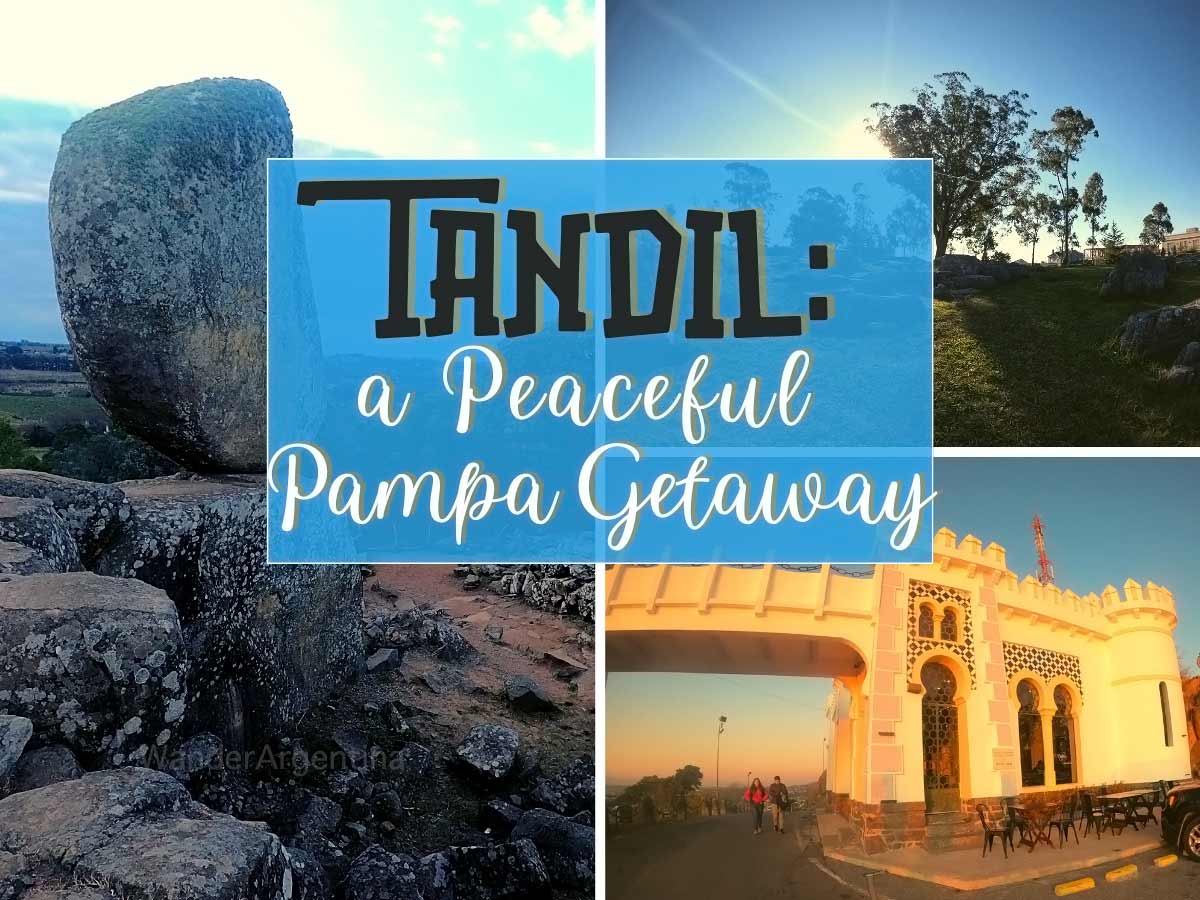
Only five hours from Buenos Aires, it makes for a nice weekend trip from the city.
In this moderate sized city a hike in any direction will lead to a hilltop with a panoramic view.
This is also a jumping off point to explore the Tandilia system of sierras.
This area contains sometimes strange-looking Precambrian rocks that date back 2.2 billion years, the sometimes strange rock formations are some of the oldest in the world.
But Tandil doesn’t just offer outdoor adventure.
The area has 50 tech startups and three universities, making it a vibrant place for a town of 110,000 people.
Tandil is inundated with the faithful during Holy Week (Semana Santa) for the Via Crucis (Stations of the Cross) procession.
History of Tandil
The name, ‘Tandil’ is an indigenous Cacique word meaning ‘the beating rock.’
It references to a now-mythical monument of this city, the Piedra Movediza (the moving rock).
The original inhabitants here were the Puelches, a Tehuelche people or, ‘people from the south’ (while Tehuelche means ‘brave people’).
They were hunters and gatherers who lived in horsehide teepees and hunted with arrows and boleadoras, a native hunting instrument made of two balls, also seen in some of Argentina’s folkloric dances.
Upon Argentina’s independence a colonial expansion was planned for this area that would destroy the Puelches way of life.
In 1823 Colonel Martín Rodriguez established military base, named Fuerte Independencia (Fort Independence) here.
The then-governor thought the vast and wide extension of the valley would be perfect for cattle farming but they weren’t counting on fighting with the Puelches intermittently for the next several decades.
A Victorian-era Tourism Destination
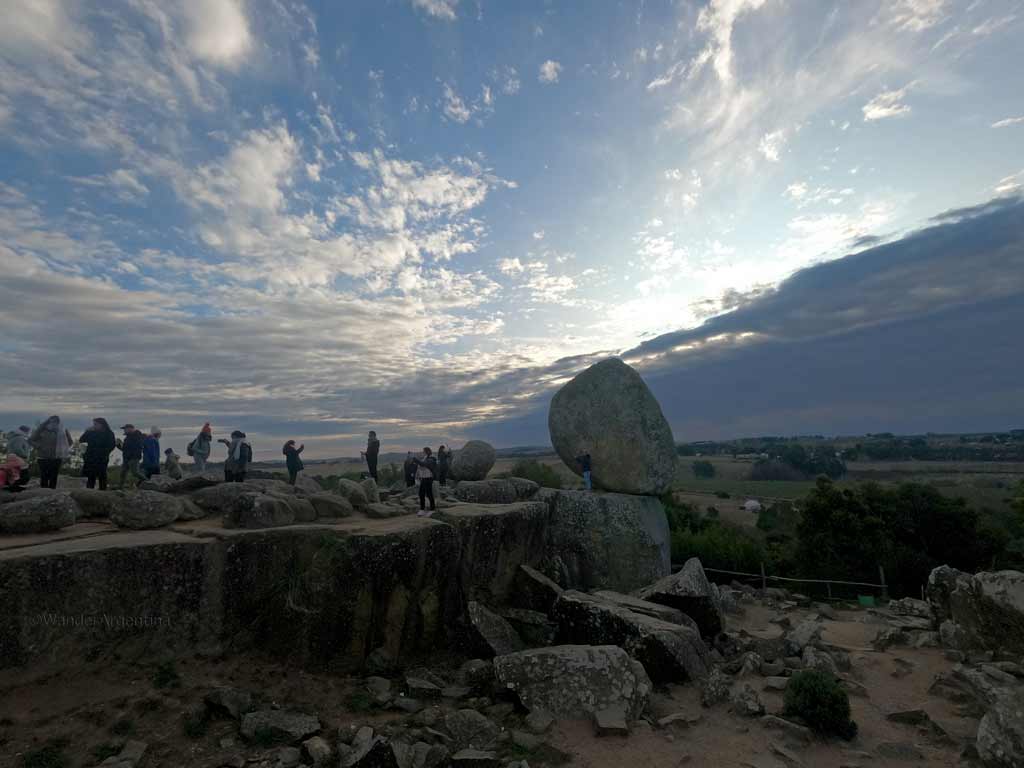
Soon after a railroad from Buenos Aires was completed in 1883, Tandil grew into a weekend tourist destination.
The biggest attraction back then was Piedra Movediza, a rock that teetered on a natural stone ledge for ions before it fell and smashed to pieces in 1912.
Tandil is celebrated for its artisanal production of deli meats and sausages, salami being the most popular (and a must-try if you’re visiting).
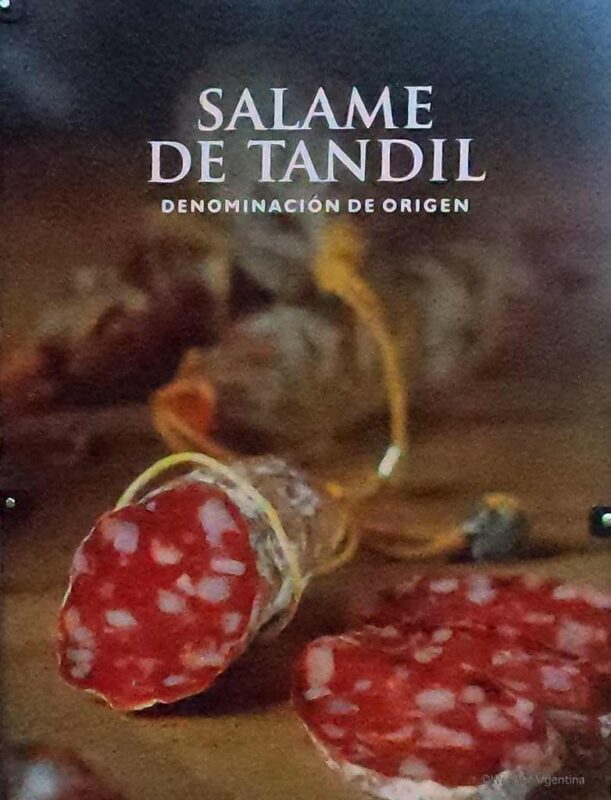
Every year in November, a contest is held to make the longest salami. So far the record for the longest salami is almost 100 meters (328 feet).
Cheeses are also famous, with another yearly festival called ‘Fiesta del Queso Tandilense,’ in early December in 2022.
A dam and artificial lake on the town’s southern side is a popular recreational area for fishing, sunbathing and sipping yerba mate.
Attractions & Things to Do in Tandil
Tandil lends itself to wandering around town, with a lake and recreational area, the central plaza, rocks to climb, religious statues and monuments dedicated to San Martín.
Tandil’s founder was a superfan of José de San Martín, the Liberator of Argentina, so it’s only be natural that the city has an entire hill dedicated to him.
Liberator Hill (Cerro Del Liberator)
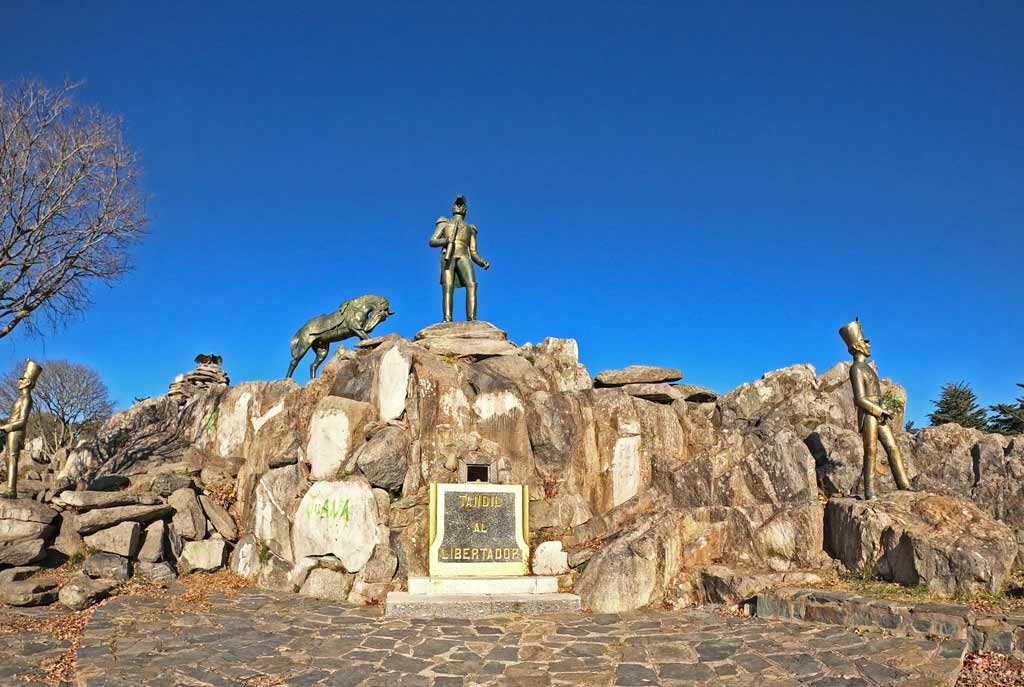
‘Cerrito’ or ‘little mountain’ in the middle of the city is a popular meet up spot to chat and drink yerba mate or dog walk.
Officially called ‘Cerro del Libertador,’ locals refer to it as ‘el cerrito.’
It’s an easy, quick hike.
At the very top you’ll find a big monument of San Martin, his horse and two grenadiers with their swords drawn as a sign of protection.
Below it, a plaque reads ‘Tandil al Libertador‘ (Tandil of the Liberator).
Typically, locals roam around the hill because of the proximity to the city.
Bringing your camera or your phone for some landscape photos.
Independence Park & the Moorish Castle (Parque Independencia & Castillo Morisco)
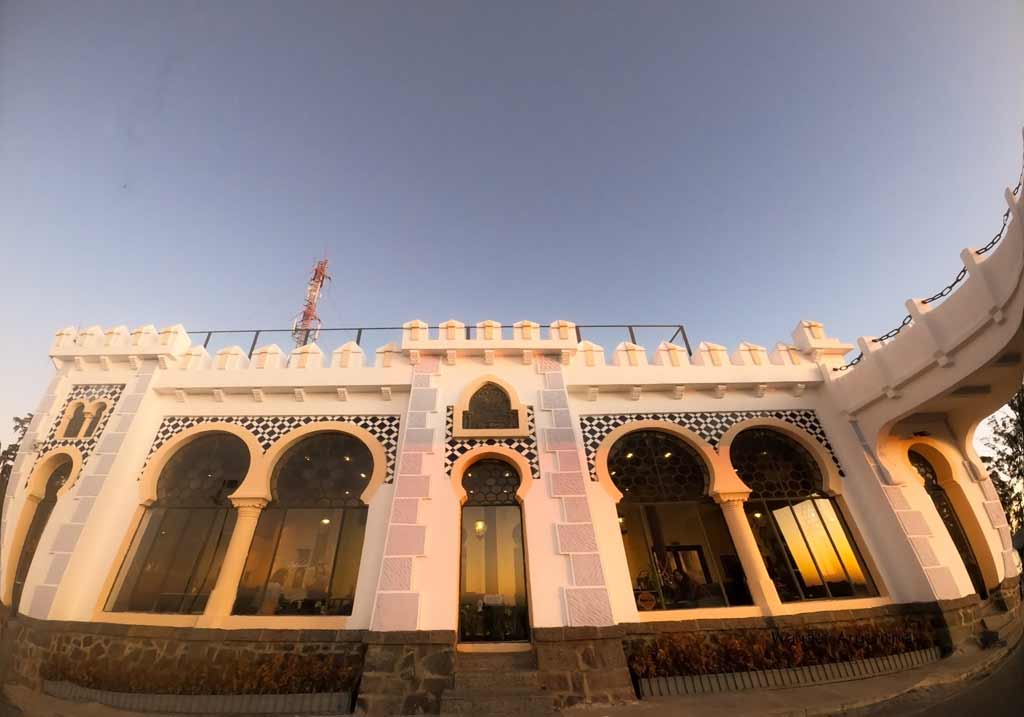
Independence Park, where the founding fort was built in1823, is just a few blocks away from El Cerrito.
A Renaissance style arch donated by the Italian community, celebrating the hundred-year anniversary of the town, marks the entrance.
To arrive at Moorish Castle walk through the Parque Independencia.
A steep set of stairs leads up to the Moor-style ‘castle.’
The alcazar-style hangout was built by the Spanish community in Tandil on the town’s hundredth anniversary in 1923.
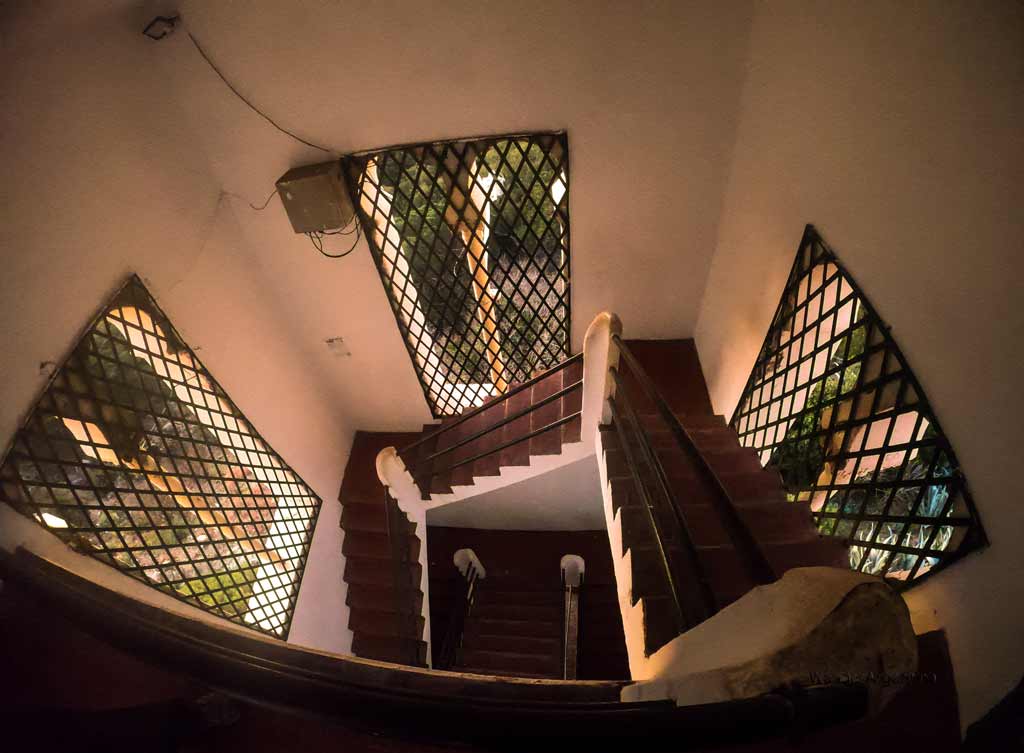
Today it serves as a restaurant and cafe.
The speciality here are the alfajores, two soft cake-like cookies filled with dulce de leche and dipped in chocolate. Alfajores Tandilense are similar to those of nearby Mar del Plata – the only difference is Tandil’s alfajores are smaller.
During merienda (tea time) there are sandwiches, pastries, and coffee on offer at affordable prices considering the lovely view.
In front of the café is the tourist office and a gift shop with postcards, cheeses, wines and sausages.
On the other side of the castle, there’s a flight of stairs that leads to a terrace with city and sierra views that lend themselves to snapshots.
A high bridge that leads directly to a statue of General Martín Rodriguez, the founder of the city.
The best time to head to the castle is a little before sundown to catch the sunset.
Bring a jacket in fall and winter, because temperatures are chillier up there.
El Dique & Lago del Fuerte
El Dique (the dam), with its artificial lake, Lago del Fuerte recreation area is the city’s biggest outdoor hotspot, right next to the castle.
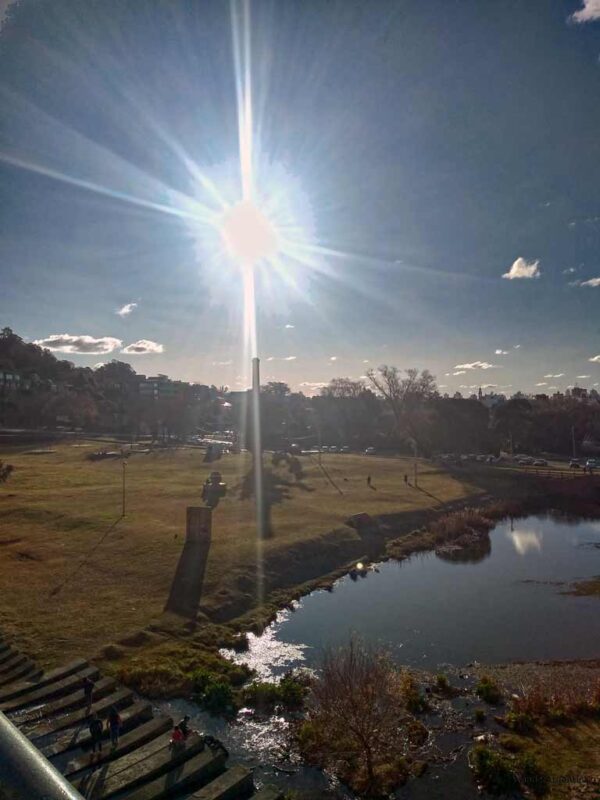
Early in the morning, people kayak on the lake.
During the day locals come here for dog walking, fishing, to make some asado using the public grills and exercise.
CrossFit is common choice – the park has public equipment for the high intensity exercises.
On the weekends there’s a local fair with handicrafts, such as wood picada (meat and cheese) trays, leather belts and mate gourds.
Fishers can easily catch carp or even a silverside fish in the dam but it’s catch and release as the water is too contaminated to eat them.
In spring and summer, on the dam’s southside there’s Municipal Beach with free public pools and a volleyball court.
Mysterious Walkway (Camino Misterioso)
Heading southwest from the dam, is Mysterious Walkway (Camino Misterioso): an area where a strange phenomenon occurs.
While one perceives the road is going downhill, for some unknown reason, when braking the car on the descent, instead of going downhill, the car feels as though it is ascending a hill.
It happens on both sides of the road.
The locals say that it may be a magnetic field pushing the car, others say that it is an optical illusion.
The Camino Misterioso is fun experience that many visitors enjoy, and it is considered a must.
Plaza Independencia
Walking through the city center, Independence Plaza is the central park of the city, featuring a San Martín monument right in the center (the founding father is the most popular guy in the city).
There are also some religious sculptures, right in front of the Blessed Sacrament Church (Iglesia del Santísimo Sacramento) built in 1878.
City hall, built in 1912 is also in the plaza.
As with el cerrito, locals ignore the actual name of this park and call it ‘plaza del centro’ — something to keep in mind if asking for directions.
Throughout the park there’s an exhibit of paintings and photographs made or taken by well-known local artists from Tandil.
This park is the locals’ favorite place to sit down and relax after a shopping spree, as it’s right in the city center.
During the week, there are a few vendors selling anything from plant pots to popcorn.
On the weekend there’s a bigger street fair where local entrepreneurs offer handmade crafts, food, books and baked goods.
Tandil is literally a town of fat cats.
The friendly stray cats that roam around Plaza Independencia are so fat from being overfed by locals, they were put on a diet.
Municipal Museum of Fine Arts
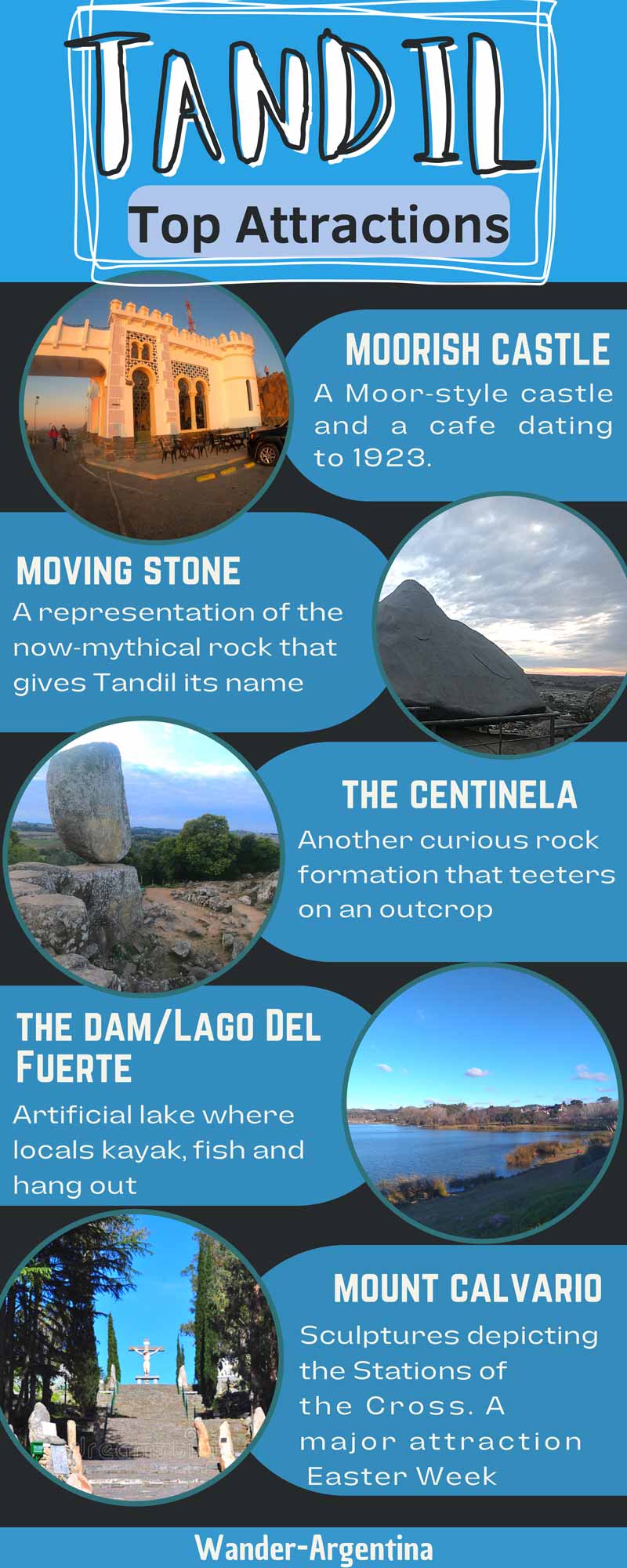
Tandil’s Museum of Fine Arts sits a block away from the main plaza at Chacabuco 357.
Growing out of a free fine arts academy of artists inspired by the landscape in the early 19th century, the museum is known for its collection of artwork by national artists such as Quinquela Martín (founder of Buenos Aires’ Caminito) and Antonio Berni, whose work can be seen in at the national art museum, MALBA and Galerías Pacifico shopping center in Buenos Aires.
The Mercedes Santamarina Room is a European art collection of 19th century paintings and sculptures bequeathed to the museum.
Remodeled and re-opened in 2019, the white and red room displays a large portrait of Mercedes.
Next to her portrait, an even larger one of his grandfather Ramon Santamarina.
In between rococo style clocks, french china and antique candlestick holders are art deco sculptures and a golden harp.
The museum (although small) exhibits itinerant contemporary art by local photographers, painters, potters, musicians and ongoing performances.
The Moving Stone (Piedra Movediza)
Located on top of a hill on the northwest of the city, the Piedra Movediza (moving stone) is a replica of the original 300 tons granite stone for which the town is named/
Lots of myths surround the origin of this stone and its location but it’s a cultural emblem of Tandil.
So named because it constantly swayed from side to side ever so slightly on the vertex of the rock outcropping.
Much like the rest of the city’s attractions, it’s really easy to get to it because it’s right in the city.
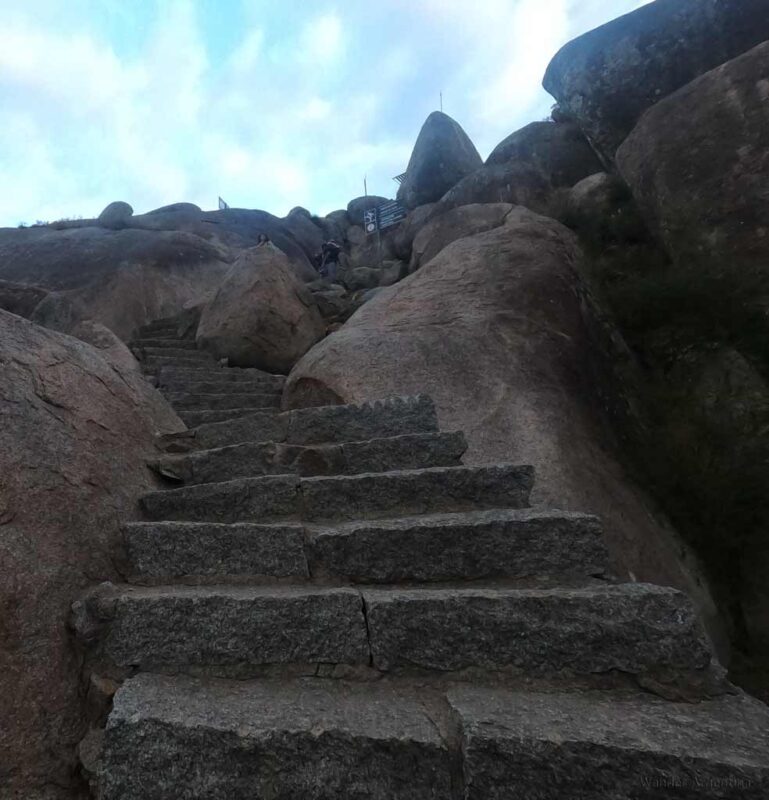
The land was donated by Ramon Santamarina, a Galician-born rancher and businessman.
Santamarina’s name is all over town because he donated numerous pieces of land in Tandil when the city was being landscaped in 1920, including where the location of Piedra Movediza.
The original stone ended up mysteriously falling off the hill in 1912, with no known witnesses.
The fall was presumed to be vandalism. Visitors had a tradition of placing bottles under the teetering stone, which could have easily ended up throwing it off the hill.
Or the fall could have been due to vibrations from explosions in nearby quarries.
Some others say it was toppled by order by Juan Manuel de Rosas (Buenos Aires’ governor at the time) as that was just his caudillo style.
What remains of the original moving rock can be seen from top of the hill.
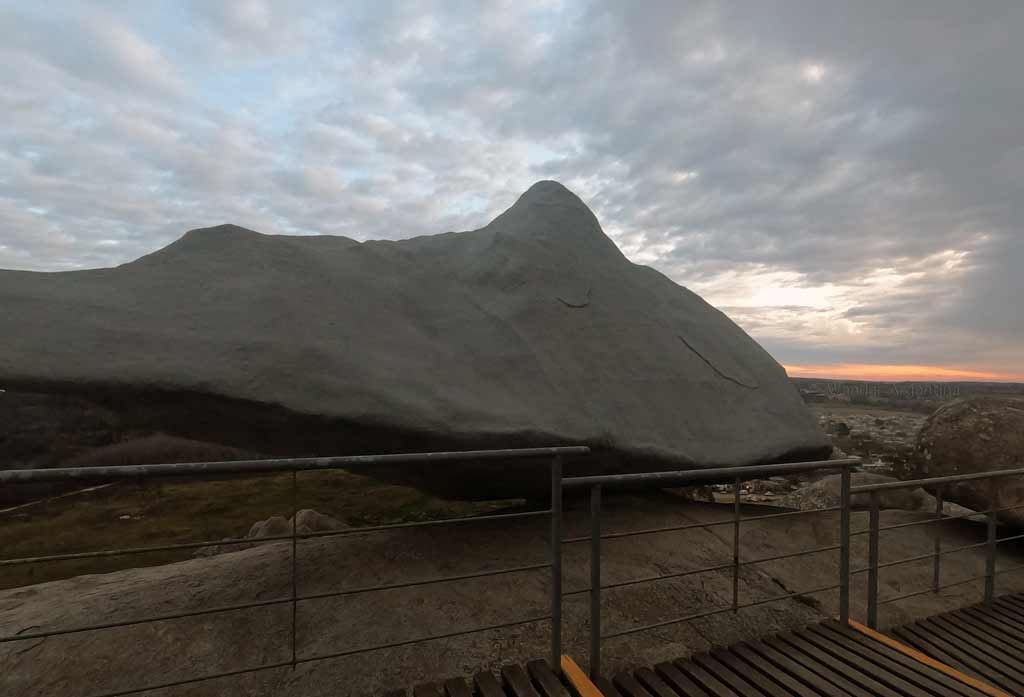
There’s been a replica of the stone since 2007 when former president Nestor and now vice-president Cristina Kirchner, donated a replica, in an effort to revamp tourism in the city.
The park area has local handcrafters and artisans selling their wares.
This climb up seems longer than it is. Although short (maybe a 15-20 minute hike), it is a very steep climb with long steps, so wear comfortable shoes.
Up top there’s a rewarding view of the city and surrounding sierras.
Mount Calvary (Monte Calvario)
Tandil is a city that, aside from the San Martin references, also has a lot of religious sculptures and symbols.
The biggest one being El Calvario. West of the city where there is a ‘Via Dolorosa’ (Way of Suffering) takes place every Easter.
It’s almost one hundred steps up on a path lined by eucalyptus, pine and olive trees. There’s a resting spot on the way up.
The view on the way up features 14 huge sculptures created by nine different artists, depicting the life of Jesus Christ, all his journey from his sentencing to his crucifixion.
At the base there are regional shops, restaurants, a tea house, and a grill.
This is not just a place for religious devotees, as reverent locals also come to place offerings for their lost loved ones on the steps.
Some people tie ribbons on the railings with their loved ones’ names written on them, leaving anything from baby shoes to liquor flasks. Some even spread their loved ones’ ashes here.
Walking through the steps and reaching the final sculpture is impactful, between the religious representation, and the amount of offerings left for the dearly departed.
A secondary path that leads to two antique chapels built in 1947, where locals get married, baptize their babies, or simply go pray.
The Sentinel (El Centinela)
Another precarious rock formation, El Centinela, is five kilometers southwest of the city.
The 70 ton granite stone is approximately seven meters high.
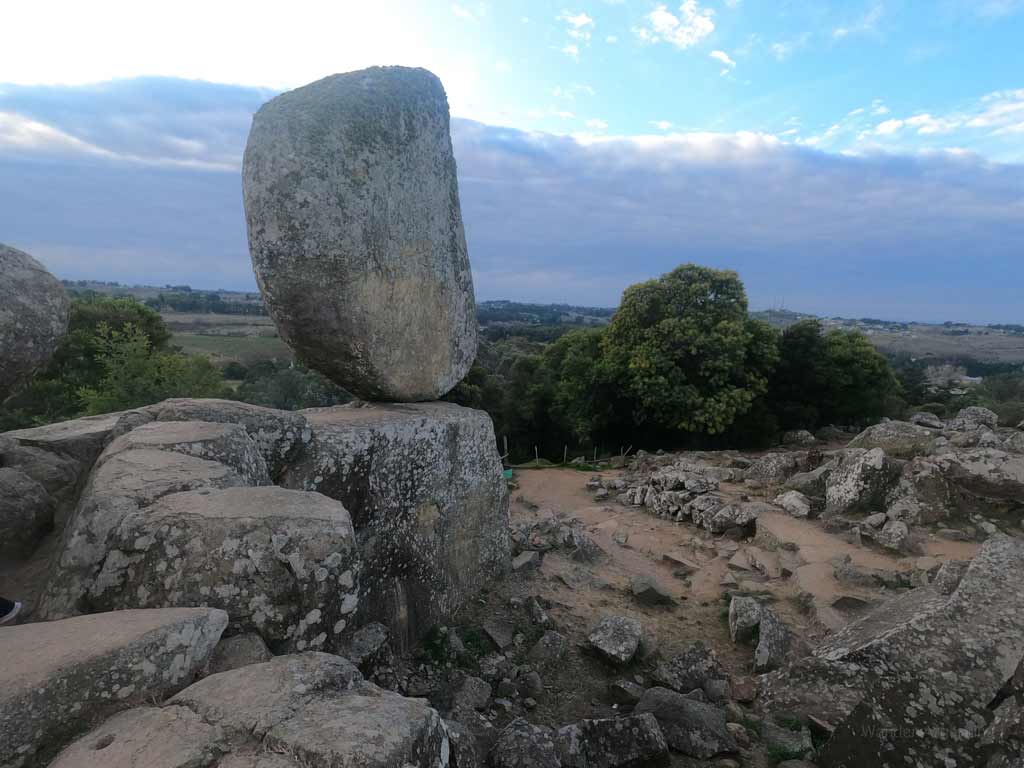
According to legend, this is where a native Cacique warrior turned to stone waiting for his lover. The woman was a Cacique named Amaik who had incredible ability to walk stealthily among the hills in the dark to spy on opposing troops, aiding them to win battles against soldiers.
Centinela means “guard or lookout’ and this is where the warrior Yanquetru would wait for her at night.
One night when Amaik was captured by two soldiers and never showed up. She had been executed.
El Centinela is where Yanquetruz turned to stone waiting for her.
Activities for children here including a playground, a zip line and tour guides who tell the story of El Centinela and a playground.
There is also a parilla, cabins, a hostel, a tourist box office.
It’s a short and easy hike to see the rock formation.
A chair lift is mainly used to take panoramic pictures. There are also bike rentals, horse riding, and tours for adults, in Spanish and English.
The Sentinal is the one obligatory place to take a picture in Tandil.
Valle del Picapedrero
Close to the Centinela is the adventure park, El Valle Picapedrero (The Stonecutter’s Valley).
This 24 hectares (60 acre) recreational area for both kids and adults has trekking trails, zip lines, rock climbing, suspension bridges.
There is also a picnic area and a restaurant.
There’s not a bus that can take that goes directly to the valley or El Centinela, but it’s only a fifteen minute drive out of town if renting a car or taking a taxi or remis.
Nightlife in Tandil
It’s not Buenos Aires, but Tandil has a fun weekend nightlife scene.
The center of town offers bars and breweries, dance clubs (mostly playing reggaeton and cumbia), karaoke bars, an anime-themed bar & an arcade and pool bar, bowling alley, and a casino.
Popular hang out spots with live music on the weekends include Brothers, Ogham and Antares Brewpub, which gets packed on the weekends.
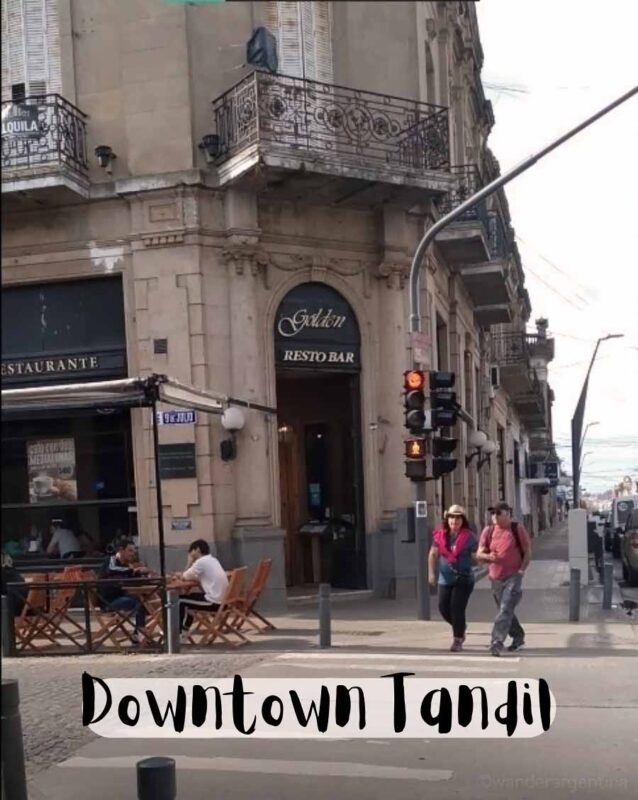
Since Tandil is so small, all the nightspots are walking distance from each other, so no taxi is needed.
Locals say it’s impossible to get bored in Tandil, because you can just wander on to the next hotspot.
Residents of Tandil (known as ‘Tandilenses‘) have a reputation as friendly folks prone to strike up a conversation out of nowhere.
Walkability & Accessibility
Tandil is walkable and safe town to wander the town or climb hills.
Unlike Buenos Aires where it’s important to keep safety in mind while using camera equipment or phones on the street, strolling leisurely around the city center at all hours in Tandil is a worry-free experience.
Tandil is an accessible city with audible traffic lights and Braille menus, required by municipal law.
Easter Procession & Other Annual Events
Easter is Tandil’s busiest time of year when they have the yearly Via Dolorosa, a prayer procession recreating the stations of the cross at Mount Calvary.
There’s also an annual folkloric festival, Festival de las Sierras in February.
In a nod to the local food specialities, there’s an annual salami contest to compete for the largest salami and the Fiesta del Queso Tandilero (Tandil Cheese Festival), shortly after in December.
Climate
If visiting during fall/winter, it is advised to bring winter coats and clothing, as this city is much colder than Buenos Aires.
Early in the morning and in the evening when the sun goes down, the temperatures can get down to below 0°—5° celcius (32-41 F), sometimes it can even be below zero.
If visiting during spring/summer it can get hot, as the rocks soak up heat, although a light jacket may be needed in the evening in spring.
How to Get to Tandil
Tandil is a four and half hours drive from Buenos Aires on RP2. Drivers should have change on hand because it’s a toll road.
Unfortunately the train that helped make Tandil a tourist destination a century ago isn’t operating anymore. But Tandil is easily accessible by bus.
Several buses head here daily from Buenos Aires’ Retiro station and from nearby Mar del Plata.
Adventurers could even make the trip in a two day bike ride.